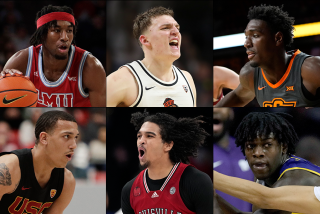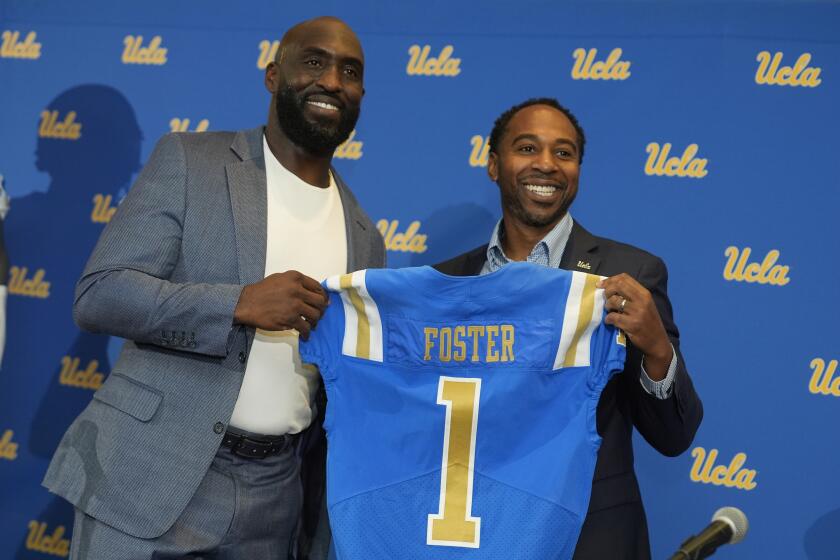Recruiters Go Aboard in Search for Big Men
- Share via
As the Soviet National team meets the NCAA on its U.S. tour, we’re getting an opportunity to see some pretty good players, among them Pelkowski, Cvijanovich and Muehlebach.
And those guys are the collegians.
Magnus Pelkowski became an Indiana Hoosier by way of Bogota, Colombia, but Stacey Cvijanovich of Nevada-Las Vegas is really a native of Oxnard, Calif., and Arizona freshman Matt Muehlebach comes from Stilwell, Kan.
The point is, with more foreign-born athletes playing college basketball in this country than ever before, you can never be sure whether these people hail from Bulgaria or Boise.
Louisiana State Coach Dale Brown, who has probably logged more frequent-flyer miles than anyone in quest of foreign talent, has helped perpetuate this trend.
A couple of years ago, Brown tried in vain to get a Soviet star to suit up with the Tigers. This season, he will have Jose Vargas of the Dominican Republic at center and Neboisha Bukumirovich of Yugoslavia -- one of the few small foreign players in the NCAA -- at reserve guard.
Plus, Brown is hoping his latest find, 6-foot-10 Hernan Montenegro of Argentina, will learn the language and be ruled eligible in time for LSU’s Dec. 16 game against Georgia Tech.
“The reason we went to foreign recruiting was the players were an untapped resource,” Brown said in a phone interview. “They don’t get the publicity and the headlines and all the tinsel and Hollywood previews that we give our guys, but they’re excellent players.”
Brown, who has toured more than 50 countries scouting, giving clinics or preparing teams for tournaments like the Olympics, also admires the personalities of these non-Americans.
“They have a burning desire to get a degree in this country,” he said. “Ninety percent of ‘em are ahead of our students (in that area). And I like their spirit, the kind of pioneer blood they have to come here to prove they can play.”
Almost all the foreign-born players are centers or power forwards.
“Everybody’s looking for the big guy,” Brown said.
A geographic glance finds 6-10 Rony Seikaly (Lebanon) at Syracuse; 7-1 Tito Horford (Dominican Republic) at Miami; 7-3 Rik Smits (Holland) at Marist; 7-1 Rolando Ferreira (Brazil) at Houston; 6-11 Marco Baldi (Italy) at St. John’s; 7-0 Eric Fleury (France) at Siena; 6-9 Sasha Radunovich (Yugoslavia) at Wichita State; 6-8 Ed Fromayan (Liberia) at Texas Christian, and 7-3 Michel Bonebo (Ivory Coast) at St. Michael’s in Vermont.
Smits, better known as the Dunkin’ Dutchman, could have been part of a United Nations frontline with the Red Foxes. However, Peter Krasovec was summoned home by the Hungarian military and Miroslav Pecarski was called back to Yugoslavia to begin training for the Summer Games.
Next year, we may see Krasovec or Pecarski touring this country with his national team. That kind of experience has helped foreigners learn the U.S. style of play; so has an increased number of American coaches who have gone abroad.
Brown, though, thinks television has become the No. 1 educational tool.
“The satellite system has done it,” he says. “The fact is, (foreigners) can watch Americans play. What says a kid in Buenos Aires can’t play as well as a kid from Baton Rouge? Now, it’s monkey see, monkey do.”
According to Brown, recent NCAA rules -- one which requires a player to pass an English proficiency exam, another which subtracts a season of eligibility for every year with a club or national team -- are making it tougher for foreigners to perform at American schools.
But there’s plenty of them around here now. So today, if you’re unable to tell the players even with a program, maybe it’s time to purchase an atlas as well.
More to Read
Go beyond the scoreboard
Get the latest on L.A.'s teams in the daily Sports Report newsletter.
You may occasionally receive promotional content from the Los Angeles Times.










